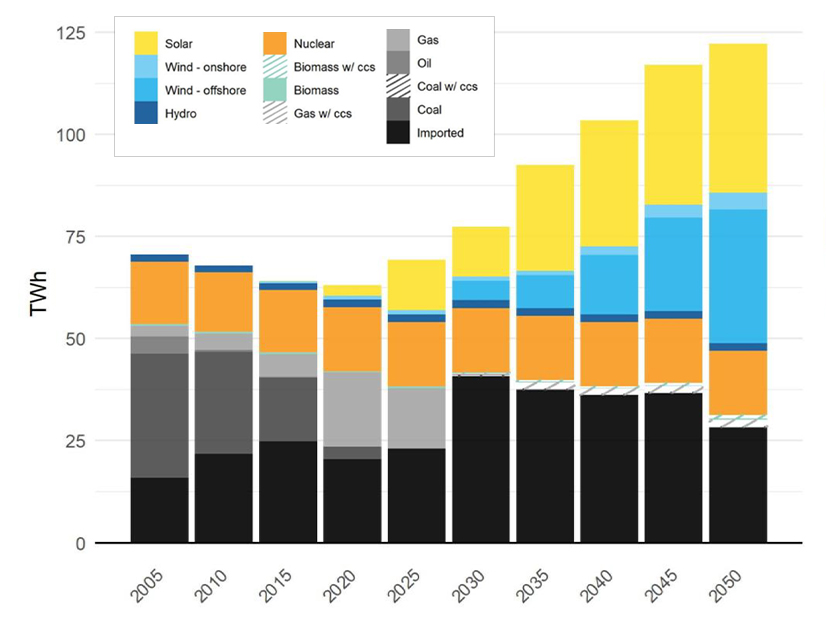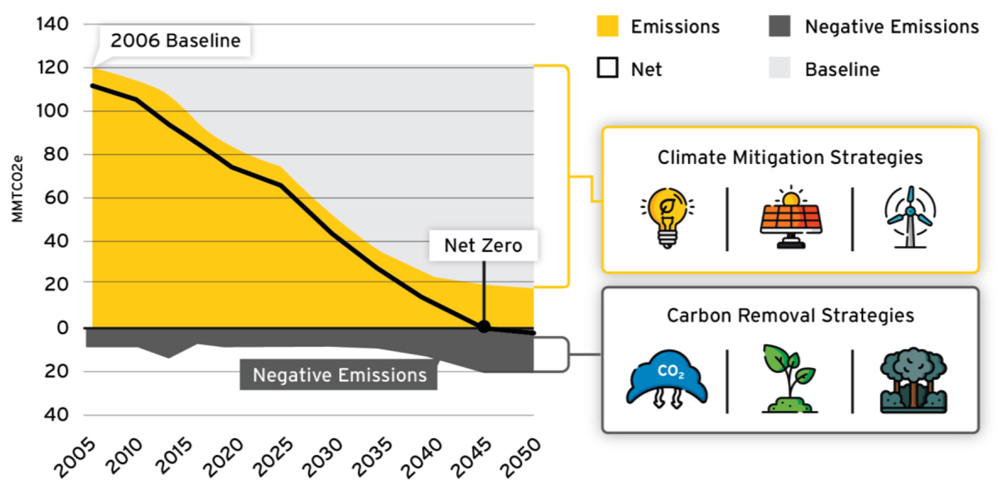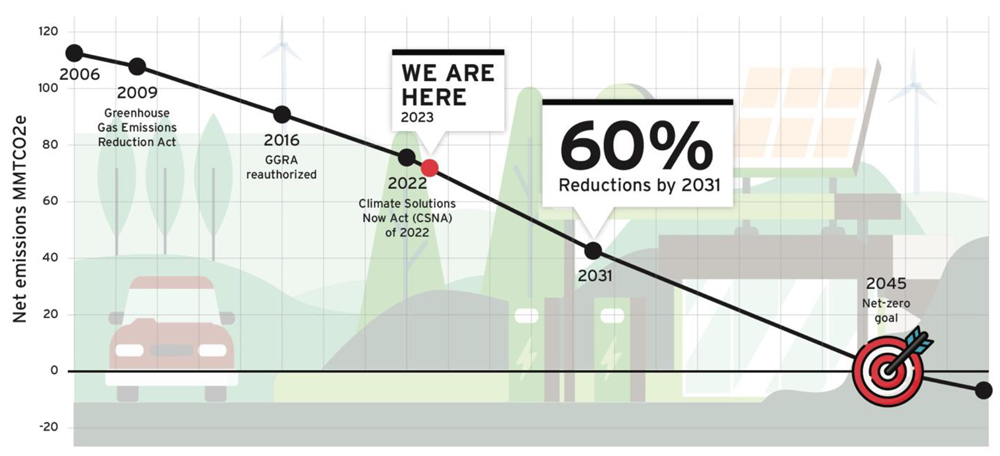
To cut its greenhouse gas emissions 60% below 2006 levels by 2031, Maryland will need to grow solar and wind generation 500% across the state, while pushing for early closure of natural gas plants and convincing the 11 other states in the Regional Greenhouse Gas Initiative (RGGI) to up their emission-reduction targets to 100% by 2045.
Those ambitious goals are just a few of a long list of actions the state could take to reach the GHG-reduction and clean energy targets set out in the Climate Solutions Now Act (SB 528) passed in 2022, according to the Maryland Climate Pathway report released recently by the state’s Department of the Environment (MDE). (See Md. General Assembly Sends Climate Solutions Bill to Hogan.)
The 60% cut is an interim step toward the law’s goal for Maryland to slash GHG emissions to net-zero by 2045, one of the most ambitious climate goals in the country. Another provision of the law required MDE to draft a plan for implementing the CSNA, to be submitted to the governor and General Assembly by June 30.
The Center for Global Sustainability at the University of Maryland College Park authored the report, which was released on June 30, kicking off a comment period and a series of live and virtual public hearings. The first live public hearing is scheduled for July 25 at Bowie State University in Bowie.
A final virtual hearing is scheduled for Sept. 26, and a final report is due by year-end.
Gov. Wes Moore (D) hailed the report as a “science-based path” and “a major step forward in addressing the historic challenges we face when it comes to our climate goals.”
“The report outlines a host of options to not only help address climate change, but also to help create a new center for industry in Maryland that will promote equity, ensure economic benefit and make Maryland a world leader in sustainable practices for generations to come,” Moore said.
“The integrity of the report is strong,” Kim Coble, executive director of the Maryland League of Conservation Voters, agreed, while stressing the 118-page document is neither a policy statement nor a final set of decisions or recommendations.
“It was never meant to be a policy statement,” Coble said. “It says, ‘Here are pathways to get to this very ambitious reduction goal. … You can do this; you can do that; you can accelerate here.’”
Accelerated action by lawmakers and others will be critical, Coble said. The report notes that Maryland already is halfway to the 60% target, with GHG emissions down 36.7 million metric tons (MMT) as of 2020. But the report says that even if all of the CSNA’s provisions, along with other existing state policies, are fully implemented, Maryland still will fall short of the 2031 target by about 10.6 MMT.
Filling that gap will require new policy actions that may or may not be politically or economically feasible, says Michael Powell, an environmental lawyer at Gordon Feinblatt, who previously served as principal counsel for MDE.
For example, the report calls for new standards requiring zero-emission home appliances and all-electric new construction, goals that Powell says may be overly ambitious, given the diverse demographics and political leanings across different regions in the state.
“People seem a little more willing to look at heat pumps in new construction, but there seems to be very strong resistance to giving up gas stoves,” he said.
Other potential steps on the report’s pathway to the 60% cut in GHG emissions include:
- creating an in-state, economy-wide cap-and-invest program, in addition to RGGI;
- shifting the passenger vehicle fleet and medium- and heavy-duty trucking fleet to zero-emission vehicles via implementation of California’s Advanced Clean Cars II rule, which Moore adopted earlier this year, and the clean trucks targets set in the Clean Trucks Act signed into law in April;
- updating the state’s building codes and setting new building performance standards;
- shifting the electricity Maryland imports to clean power by getting RGGI to set a 100% emissions reduction goal by 2045; and
- leveraging the green hydrogen and carbon capture tax credits in the Inflation Reduction Act to develop alternative fuels and energy sources in the state.
Under the Advanced Clean Cars II rule, all new light-duty and passenger vehicles sold in the state will need to be zero-emission by the 2035 model year. The Clean Trucks Act calls for MDE to set regulations for increasing sales of zero-emissions trucks by Dec. 1, 2023, but also to perform a needs assessment report by Dec. 1, 2024.
Possible, not Probable
A major concern about the report is its lack of specificity on how its ambitious goals will be achieved, what the price tag will be and how those costs will be allocated.
For example, Powell pointed to considerable obstacles to decarbonizing imported power, which accounts for about 40% of its electric power, according to the U.S. Energy Information Administration.
Beyond PJM’s massive interconnection queue — which stands around 290 GW, most of which is renewable energy and storage — Powell sees growing opposition to utility-scale solar across the state, a trend that is occurring across the country.
“Pile those one on top of the other, [and] it means that utility-scale solar is actually down in the state,” he said. “The plan calls for PJM [states] to adopt a net-zero target. Looking at the political landscape, I think that’s a real challenge.”
Coble also noted that the report makes some faulty assumptions about current levels of renewable energy adoption in the state. The state’s current renewable portfolio standard — calling for 50% of the state’s power to be renewable by 2030 — includes a 14.5% carve-out for solar. But according to the Solar Energy Industries Association, solar now provides only 5.17% of the state’s power.
Powell sees the goals set out in the report as possible, but maybe not probable.
“We need to find out, is the General Assembly willing to put the kind of funding and incentives for some of the proposals in the report?” he asked. “Because I personally do not believe that private enterprise can achieve those goals without a lot of state funding.”
Coble said another key factor will be “courageous leadership from our elected officials, from this administration. Courageous leadership is going to make or break the success of this, more than anything else.”





